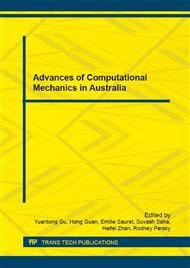p.541
p.547
p.553
p.559
p.565
p.571
p.577
p.583
p.589
A Study of Abrasive Wear on High Speed Steel Surface in Hot Rolling
Abstract:
In hot rolling, the thermal cyclic of work rolls causes a superficial oxide scale, which plays an important role on the contact friction and wear. The asperities of oxidised strip surface and wear debris slide over the High Speed Steel (HSS) work roll surface which comprises of hard carbides within an iron matrix under high pressure and velocity. Abrasive wear occurs and the particles will be removed from HSS surface. The current study introduces the Discrete Element Method (DEM) to investigate this abrasive wear phenomenon. The model successfully provides a physically based abrasive roll wear predication of HSS work roll with the consideration of carbides and oxide layers. It has been found that the carbide shape in the HSS roll affects the wear significantly, which has not been reported by previous numerical simulations and is the main focus of this research.
Info:
Periodical:
Pages:
589-594
Citation:
Online since:
July 2016
Authors:
Price:
Сopyright:
© 2016 Trans Tech Publications Ltd. All Rights Reserved
Share:
Citation:


